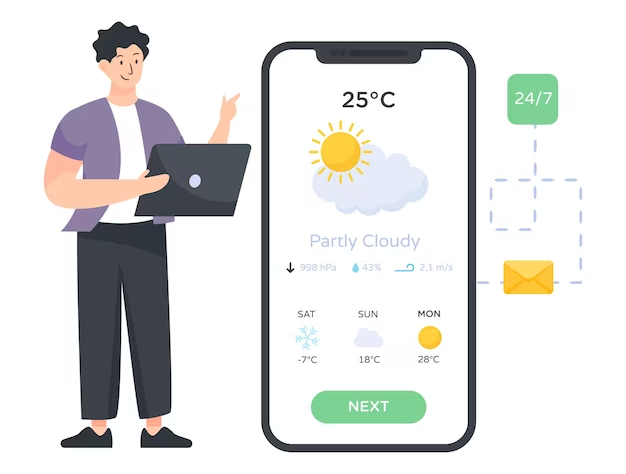
Weather forecasts play a vital role in our travel plans, and weather apps have become indispensable tools for accessing timely and reliable information. Beyond accurate forecasting, these apps offer many essential features and functionalities.
Weather app documentation has made them a staple on nearly every smartphone. These apps have consistently ranked among the most frequently accessed applications in recent years. While the market may appear saturated, ample opportunity exists to capitalize on the demand. Innovative approaches, user-centric design, and additional features can set your weather app apart in this competitive landscape.
By recognizing the diverse needs of users and providing comprehensive solutions, you can create a valuable and sought-after weather app experience. In this blog, we will understand the estimated cost of weather apps and the factors influencing the budget.
What is the Weather Forecast App?
Weather forecast apps are essential tools for informed decision-making. They give you continuous weather updates and mention other changes in the weather as well. These apps go beyond just temperature, offering comprehensive data like sunrise and sunset times, precipitation timing, humidity levels, and more. They act as compact weather devices, delivering precise and timely information to help users plan their day without any problem.
Key Factors You Need to Find in a Weather Forecast App
When selecting a weather app, it’s essential to consider several key factors to ensure you’re getting accurate and reliable forecasts. It can be a tough job to select the right app. Here’s what to look for:
- Data Sources
Start by examining the sources of weather data used by the app. Most reputable weather apps rely on official government sources like the National Oceanic and Atmospheric Administration (NOAA) or the European Centre for Medium-Range Weather Forecasts. Some apps enhance government data with proprietary models or algorithms. Avoid apps that do not disclose their data sources, as transparency is crucial for trustworthiness.
- Privacy Policies
Weather apps often require access to your precise location for accurate forecasts. However, these data can be used for other activities as well. So, read the privacy policy thoroughly. Choose apps that are transparent about their data usage and offer clear privacy controls.
- App Developer Reputation
Research the developer or company behind the weather app. Opt for apps developed by well-known companies with an established online presence, including a website and active social media profiles. Reputable developers are more likely to provide reliable and updated weather information.
- User Reviews
User reviews in the app store can provide valuable insights into the app’s performance and accuracy. Always remember that these reviews are not transparent enough for you to believe in them without checking the real facts. Consider the overall rating and read a variety of reviews to gauge user satisfaction.
- Accuracy Considerations
Assessing the accuracy of weather apps can be challenging, as it depends on factors like your location and the type of weather being forecasted. Recognize that most weather apps have comparable accuracy levels, with slight variations. A 0.5% to 1.5% difference in accuracy is often negligible for everyday use.
- Additional Features
Consider whether the app offers additional features that align with your needs. Some weather apps provide detailed radar maps, severe weather alerts, pollen forecasts, air quality information, or customizable notifications. Choose an app that offers features relevant to your preferences and lifestyle.
- User Interface and Experience
Evaluate the app’s user interface (UI) and overall user experience (UX). Designing can be a plus point for your app. A cluttered or confusing interface can hinder your ability to access weather information efficiently.
- 8. Pricing Model
Understand the app’s pricing model. While many weather apps are free to download, some offer premium subscriptions or one-time purchase options for advanced features.
- Updates and Maintenance
Ensure that the app receives regular updates and maintenance. These weather data are continuously changed and updated for a real-time weather forecast.
- Customization Options
Look for apps that allow you to customize settings and notifications to suit your preferences. Personalization features can enhance your user experience and ensure you receive weather alerts and information relevant to your location and interests.
What are the Different Types of Weather Apps?
Weather apps come in various types, each catering to specific needs and interests:
- Climate Apps
Climate apps offer extensive features and functionalities that provide insights into long-term climate changes spanning weeks, months, or even years. These apps go beyond daily weather updates, allowing users to delve into data such as sea level trends, ozone concentration, carbon dioxide levels, gravity fields, oxygen levels in the atmosphere, and more. They are useful for research or tracking any environmental trends.
- Forecast Apps
Forecast apps are among the most popular weather app types. They utilize location services to generate real-time weather forecasts for specific locations. These apps provide weather data about temperature, wind speed, precipitation, and other changes. Basic weather features are often free, while premium or ad-free versions may require a nominal fee. Individuals widely use forecast apps for planning daily activities and outdoor events.
- Image of Changes
Image of Changes Weather apps serve educational and entertainment purposes. Their primary objective is visually showcasing climate changes and weather phenomena over a specified period.
These apps often use interactive animations, images, and graphics to help users understand and appreciate weather patterns and how they evolve. They are a priceless medium for teachers, researchers, and weather enthusiasts to understand the changes in the weather.
Each type of weather app serves a distinct purpose, from providing in-depth climate data for research to offering practical daily forecasts for everyday planning and educational tools for exploring the fascinating world of weather.
Users can choose any weather app that is suitable and follows their needs. Many mobile app development services can easily build weather apps within the budget allotted without compromising quality.
What is the Approximate Cost of Weather Apps?
The cost of weather apps can vary significantly, contingent on factors like features, complexity, geographical location, developer rates, and more. You can expect a starting cost of approximately 10,000 USD for a fundamental weather app on a single platform. But, if you desire a more sophisticated application with custom design and advanced features, the development expenses can escalate to 30,000 USD or higher.
It’s crucial to recognize that geographic location can influence the cost of weather apps, with some regions offering more budget-friendly development services. Furthermore, the pricing may fluctuate based on the chosen platforms (iOS, Android, or both) and the time required for development. For an accurate estimate, consulting with experienced mobile app development professionals is advisable, as they can provide tailored quotes based on your specific project requirements and goals.
Factors Affecting the Cost of Weather Apps
Developing a weather forecast app comes with various cost constraints, each influencing the overall budget differently.
- Application’s Purpose and Functionality
The primary objective of your weather app significantly impacts development costs. A simple weather app that provides basic forecasts will cost less than a feature-rich application with advanced functionalities like real-time radar, severe weather alerts, or location-based recommendations. So, defining your app’s purpose is essential for budget planning.
- Design
User Interface (UI) and User Experience (UX) design are pivotal in app development. A well-designed app enhances user engagement and adds to development expenses. Going for an attractive design can be costly but worth the investment.
- App Platforms
Deciding which platforms to target, such as Android, iOS, or both, affects costs. These frameworks allow you to create apps with shared code, saving time and effort
- Post-Developmental Updates
After launching your app, user feedback and bug reports will necessitate updates and maintenance. Allocating a budget for ongoing maintenance and improvements is essential. Regular updates fix issues and keep your app competitive in a constantly evolving market.
- Security
Ensuring the security and privacy of user data is non-negotiable. Building robust security measures into your app may require additional investment but is essential for gaining user trust and complying with data protection regulations. Security breaches can be costly both in terms of finances and reputation.
- Technology Stack and Integrations
The choice of technology stack and integrations also impacts costs. Using third-party services like weather forecast APIs and payment gateways may come with licensing fees. The experts of mobile app development companies in the USA can also influence costs.
- Developer Rates
The hourly rates of app developers vary widely based on their location and experience. While highly skilled developers may have higher rates, their expertise often translates into a more efficient and high-quality development process. Choosing the right development team within your budget is crucial.
- Geographic Location
The geographic location of your development team also affects costs. While outsourcing to regions with lower labor costs can be a cost-effective strategy, weighing the pros and cons is crucial. Communication challenges and time zone differences are important factors to consider.
Conclusion
Some leading mobile app development companies in the USA specializing in creating cutting-edge applications to enhance your business’s performance while maintaining cost efficiency. There are many factors influencing the cost of developing a weather app. Considering all these factors, you can smoothly create an app without the budget you thought of.






